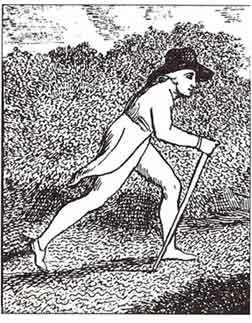|
THE
WILLIAM BLAKE TAROT
|
Table of Contents: Cover
Page |
Chapter 3
The Blake Triumphs
THE SOUL'S JOURNEY.
EXPERIENCING FALL AND REGENERATION.
THE CYCLES OF ETERNITY.
Every natural effect has a spiritual cause.
The Blake Triumphs, which correspond to the Major Arcana in conventional Tarot, are so named to emphasize and dramatize the motive of all of Blake's works, which is to triumph over the "Satanic mills" of materialism that ceaselessly strive to crush the human spirit.
—The
Borders of the Triumphs
—The Cycles of the Triumphs
. . . . [Chart 3-1]
—The
Eternity Card
—The
Soul's Journey
—The Cycle of Matter
0-Innocence
I-Magic
II-Mystery
III-Nature
IV-Reason
V-Religion
VI-Knowledge
VII-Experience
VIII-Assessment
IX-Imagination
X-Whirlwind
XI-Energy
XII-Reversal
XIII-Transformation
XIV-Forgiveness
XV-Error
XVI-Lightning
XVII-Stars
XVIII-Moon
XIX-Sun
XX-Liberty
XXI-Union
The borders of the Triumphs are from Blake's Illustrations of the Book of Job. This work is his crowning achievement, published when he was 68 years old, one year before his death. Job consists of 21 engravings telling Blake's version of Job's story, plus the title page, for a total of 22 pages — the same number as the Major Arcana of the Tarot. The Illustrations of the Book of Job embody Blake's wisdom and artistry in one singular achievement. Because its theme of the fall and redemption of man parallels that of the Tarot, the borders from Job are adapted here as the borders of the Triumphs. Their sequence was determined by their symbolic associations with the Tarot; the original placement is noted by a small number in the upper right corner of each Triumph.
Blake divided his 21 Illustrations of the Book of Job into three cycles of seven each, based the Eyes of God, which tell Job's story through each of the eyes in succession. The Triumphs are also divided into three cycles as shown in Chart 3-1, which is a useful summary of the Triumphs sequence, listing the cards according to their cycles and naming the major characters.
Chart 3-1: The Cycles of the Blake Triumphs
|
Cycle
of:
|
Segment:
|
Eternal
Figure:
|
Represents:
|
Blake
Triumph:
|
Border
Color:
|
|
Matter
|
The Fall
|
Tharmas
|
Instinct
|
0—Innocence
|
BLACK
|
|
Los/Urthona
|
Time
|
I—Magic
|
Printed in
GREY ink
|
||
|
Enitharmon/
Urthona
|
Space
|
II—Mystery
|
|||
|
Vala/Luvah
|
Feelings
|
III—Nature
|
|||
|
Urizen
|
Mind
|
IV—Reason
|
|||
|
Worldliness
|
-
|
(Spirituality)
|
V—Religion
|
||
|
-
|
(Choice)
|
VI—Knowledge
|
|||
|
-
|
(Exhaustion)
|
VII—Experience
|
|||
|
Awakening
|
Regeneration
|
Luvah
|
Compassion
|
VIII—Assessment
|
Printed in
dark BLUE ink
|
|
Los/Urthona
|
Truth
|
IX—Imagination
|
|||
|
The Four
Zoas
|
Vision
|
X—Whirlwind
|
|||
|
Tharmas
|
Strength
|
XI—Energy
|
|||
|
Urizen
|
Self-Awareness
|
XII—Reversal
|
|||
|
Transformation
|
(Time)
|
Transformation
|
XIII—Transformation
|
||
|
Jesus
|
Imagination
|
XIV—Forgiveness
|
|||
|
Spirit
|
Dark Night
of the Soul
|
Satan
|
Selfhood
|
XV—Error
|
Printed in
dark RED ink
|
|
Satan (accuser)
|
Self-Doubt
|
XVI—Lightning
|
|||
|
Revelation
|
-
|
(Inspiration)
|
XVII—Stars
|
||
|
-
|
(Intuition)
|
XVIII—Moon
|
|||
|
Jesus
|
Enlightenment
|
XIX—Sun
|
|||
|
Jerusalem
|
Freedom
|
XX—Liberty
|
|||
|
Albion
|
Unified Man
|
XXI—Union
|
|||
|
The 00/
|
|||||
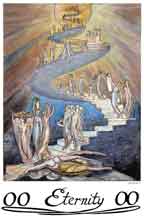 The
Eternity card has no equivalent in other Tarot decks. Its dual numberation (double-zero
or infinity) indicates that it transcends numbers. This image is from the painting
called Jacob's Dream, based on the book of Genesis, showing Jacob and his ladder
to heaven. In Blake's myth, this is Albion asleep on the Rock of Ages. His Zoas
have divided, and he lies stricken in spiritual limbo. Fallen from eternity,
he is now a mortal man, and his four "eternal senses" — the four
divine arts of painting, science, music, and poetry — have become his body,
head, heart, and genitals. Albion represents our own sleeping consciousness,
dreaming eternity as our ultimate potential. Albion remains asleep throughout
the soul's journey, unable to awaken until his divided soul is regenerated and
his Zoas, the "four faces of man," are reunited. However, his vision
of eternity is very much alive in his dream — and Albion's vision is what
this card is about. Eternity represents mankind's hopes for divine spiritual
consciousness, and for living in a world of shining imagination and everlasting
truth. For Blake, eternity is an exciting intellectual realm filled with the
"fury of poetic inspiration," from whence "all the passions emanate
uncurbed in their eternal glory."
The
Eternity card has no equivalent in other Tarot decks. Its dual numberation (double-zero
or infinity) indicates that it transcends numbers. This image is from the painting
called Jacob's Dream, based on the book of Genesis, showing Jacob and his ladder
to heaven. In Blake's myth, this is Albion asleep on the Rock of Ages. His Zoas
have divided, and he lies stricken in spiritual limbo. Fallen from eternity,
he is now a mortal man, and his four "eternal senses" — the four
divine arts of painting, science, music, and poetry — have become his body,
head, heart, and genitals. Albion represents our own sleeping consciousness,
dreaming eternity as our ultimate potential. Albion remains asleep throughout
the soul's journey, unable to awaken until his divided soul is regenerated and
his Zoas, the "four faces of man," are reunited. However, his vision
of eternity is very much alive in his dream — and Albion's vision is what
this card is about. Eternity represents mankind's hopes for divine spiritual
consciousness, and for living in a world of shining imagination and everlasting
truth. For Blake, eternity is an exciting intellectual realm filled with the
"fury of poetic inspiration," from whence "all the passions emanate
uncurbed in their eternal glory."
The sheephook in Albion's hand represents his mortal innocence. Exalted beings carry symbols of the arts (spiritual sustenance) upon a celestial stairway that literally represents the arts as man's connection to eternity. The luminous, numinous sun is the "divine imagination," the god in every human, which shines within us day and night, the ultimate reality from which all things are created.
This card is always significant in a reading, because its declaration of spiritual reality and creative imagination is meaningful in any context. Eternity can be a wake-up call to a spiritual issue in the reading, a promising opportunity to try something new and imaginative, an announcement of a something wonderful happening, a prophecy of angelic or artistic communication (perhaps via a dream or daydream), the advent of a serendipitous occurrence or heavenly 'coincidence', or a sudden awareness that life is a spiritual adventure, and not just a material process. This is always an auspicious card, even when reversed, because eternity is irreversibly divine.
KEYWORDS: AWARENESS OF SPIRITUAL DESTINY • ARTISTIC POWERS • A HEAVENLY OUTLOOK • IMAGINATIVE OPPORTUNITY • PROPHETIC PORTENTS. SPIRITUAL ELATION •
The Blake Triumphs tell a story about the spiritual progress of human consciousness. This is the Soul's Journey, which now begins...
This cycle consists of eight cards, of which the first introduces the seven that follow.
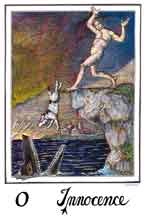 Innocence
corresponds to the Fool in conventional Tarot. It represents the soul's entry
stage into terrestrial consciousness, following its descent from eternity. The
innocent soul is naked, an unadorned spiritual essence viewed at the literal
dawn of its journey through the stages of life, and the cards of the Triumphs.
He (she) is as yet unaffected by society, symbolized by the distant city towers.
Awed by the challenges, the soul hesitates on the white Rock of Ages. Now the
leaping dog (instinct) becomes a key element in the composition. The dog senses
that the crocodile, half dragon and half serpent, embodies both magical and
mystical knowledge. Although dangerous, the only way to encounter him is to
leap into his element, crossing the threshold from potentiality to actuality.
Innocence
corresponds to the Fool in conventional Tarot. It represents the soul's entry
stage into terrestrial consciousness, following its descent from eternity. The
innocent soul is naked, an unadorned spiritual essence viewed at the literal
dawn of its journey through the stages of life, and the cards of the Triumphs.
He (she) is as yet unaffected by society, symbolized by the distant city towers.
Awed by the challenges, the soul hesitates on the white Rock of Ages. Now the
leaping dog (instinct) becomes a key element in the composition. The dog senses
that the crocodile, half dragon and half serpent, embodies both magical and
mystical knowledge. Although dangerous, the only way to encounter him is to
leap into his element, crossing the threshold from potentiality to actuality.
Blake's image was probably inspired by the constellations of Orion ('beautiful man') of Greek mythology, Canis Major (containing the dog-star Sirius), and Hydra (Serpent). Blake was quite familiar with the constellations, and a glance at a star-chart shows that they line up exactly as Blake pictured their representative characters. (Interrestingly, the Hebrew name for Orion is Kesil, which means Fool).
In the Blakean interpretation, the naked figure is Tharmas, the western Zoa of Matter, appearing in the world of Generation as eternity's fool. (Blake, a notorious punster, perhaps derived Tharmas's name from 'thermal' for body-heat, or from 'torso' or 'thorax' plus 'arms'.) Tharmas is "the parent power," the generative Zoa in the Cycle of Matter. Tharmas presides over the art of Painting because it studies and depicts the forms of matter. His element is Water, the first element mentioned in the Bible, associated by Blake with the material world and the human body because both are mostly composed of water. In addition, the body is like water in its transitory nature. In the card, Tharmas is shown reacting to the beauty and terror of material existence in Blake's metaphor of the "sea of time & space" — but elementally Tharmas is the sea — the material man in his own element. Traditional occult wisdom holds that matter is the manifestation of spirit, which is literalized in this card.
KEYWORDS: INNOCENCE OF OUTLOOK
• PROSPECT OF ADVENTURE • NEW PHASE OF LIFE • TRUSTING IN ONEÕS
INSTINCTS • DEALING WITH FOLLY • LEAPING INTO THE UNKNOWN •
Even at this first stage, many souls choose not to leap, satisfied with simply being here. The soul desiring further development now bravely takes the plunge, and commences the soul's journey...
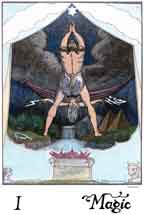 Magic
corresponds to the Magician in conventional Tarot. It represents the first worldly
state, in which the soul discovers the outer or celestial energies, and learns
how to channel and transform them into the energies of earthly existence. The
magus (Persian for 'mighty one') is the dog-headed Egyptian deity Anubis, his
feet straddling the Nile and channeling celestial energies to earth from Sirius,
the dog star, called Sothis by the Egyptians. Anubis as the psychopomp or 'conductor
of souls' was often identified with Hermes, and so he is also called Hermanubis.
The ancient Egyptians revered the star of Sothis-Sirius because its celestial
movements signaled the flood of the Nile, and became the basis of the Egyptian
(Sothic) calendar. Plutarch says Sothis was another name by which they called
the Nile. Traditionally this card depicts the Hermetic axiom, "As above,
so below"; here it becomes literal as both star and river bear the same
name.
Magic
corresponds to the Magician in conventional Tarot. It represents the first worldly
state, in which the soul discovers the outer or celestial energies, and learns
how to channel and transform them into the energies of earthly existence. The
magus (Persian for 'mighty one') is the dog-headed Egyptian deity Anubis, his
feet straddling the Nile and channeling celestial energies to earth from Sirius,
the dog star, called Sothis by the Egyptians. Anubis as the psychopomp or 'conductor
of souls' was often identified with Hermes, and so he is also called Hermanubis.
The ancient Egyptians revered the star of Sothis-Sirius because its celestial
movements signaled the flood of the Nile, and became the basis of the Egyptian
(Sothic) calendar. Plutarch says Sothis was another name by which they called
the Nile. Traditionally this card depicts the Hermetic axiom, "As above,
so below"; here it becomes literal as both star and river bear the same
name.
Because 0 represents potentiality while 1 represents actuality, the combination of the first two cards forms a binary system that defines duality, which is matter in time.The two pyramids at the right symbolize this duality. They also symbolize the conjuntio, the marriage of the primal essences of alchemy: the sulfur and mercury as anima (soul) and spiritus (spirit) that underlay the material world. In the background is the winged god of rain and thunderbolts, Jupiter Pluvius to the Romans, who represents the fertilization of the Nile, the source of life. The sistrum (the rattle of Isis) on the left riverbank represents vibration as the energy of life, and its four rattles represent the elements as the alchemical tools of the magus.
In the Blakean interpretation, the magus is Los, the manifestation of Urthona, the northern Zoa of Imagination. Like Anubis, Los is also a conductor of souls, and this is his fallen or lesser aspect as a 'Druidic' magician and active agent of materialism rather than the spiritual force he later becomes. Los, in separating from eternity, creates the new phenomenon called Time, and his major role here is that of time-lord, symbolically represented by the river of life flowing between his legs. As time, Los is a gift from eternity because he is the means by which spiritual unity will ultimately be reestablished. Time creates a way for truth to ultimately prevail, and so Los is a beneficial agent even though he practices pagan magic at this stage. Being the creator of time, he is associated with the art of Poetry or prophecy, which is truth through time. His element is Earth, symbolizing that imagination is the only solid and lasting reality. Note how different this is from the traditional tarot meaning of element Earth which denotes Materialism not Spirit.
In the border, the ram and bull at the corners represent the primal masculine energy associated with Magic, while the ram-heads on the altar imply pagan sacrifices required to propitiate the forces released in this card. The fire of life beneath the waters of time create the alchemical clouds that represent the spiritual body of man. The tent beneath the clouds encloses this world of matter, blocking the view of true spiritual reality.
KEYWORDS: ABILITY TO CONCENTRATE • WILLPOWER. BEING IN CONTROL • CHANNELING OF ENERGY • ARCHETYPAL COMMUNICATION • MAGICAL AND OCCULT POWERS • DUALITY • TIME AND TIMING • ASSERTIVE IMAGINATION •
At this stage, the fledging soul undergoes great expansion of personal consciousness and power. It is a magical achievement, sufficient for many seekers, who gladly stop here. For those who choose to go on...
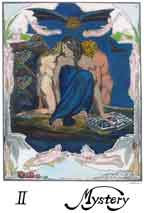 Mystery
corresponds to the High Priestess in conventional Tarot. It introduces the feminine
principle, represented by the triple goddess Hecate, who evokes the lunar power
of the subconscious. Her sacred colors are white, red, and black to symbolize
her womanly aspects of maiden, mother, and crone; her phases are the crescent,
full, and waning moons; her rulership is over heaven, earth, and underworld.
Her left hand (the sinister and materialistic side) rests on a book also being
touched by her right (spiritual) foot, signifying that its knowledge, although
occult and mysterious, is in touch with the spiritual realm. Hecate communes
with the crocodile energy of card 0, gazing at its figure to her right. Hovering
near her head is a cat-faced bat, her 'witch's familiar' or totem creature,
along with a raven, an oracle of magic. Her hair is long and flowing, a symbol
of her power over men and nature.
Mystery
corresponds to the High Priestess in conventional Tarot. It introduces the feminine
principle, represented by the triple goddess Hecate, who evokes the lunar power
of the subconscious. Her sacred colors are white, red, and black to symbolize
her womanly aspects of maiden, mother, and crone; her phases are the crescent,
full, and waning moons; her rulership is over heaven, earth, and underworld.
Her left hand (the sinister and materialistic side) rests on a book also being
touched by her right (spiritual) foot, signifying that its knowledge, although
occult and mysterious, is in touch with the spiritual realm. Hecate communes
with the crocodile energy of card 0, gazing at its figure to her right. Hovering
near her head is a cat-faced bat, her 'witch's familiar' or totem creature,
along with a raven, an oracle of magic. Her hair is long and flowing, a symbol
of her power over men and nature.
This image of the triple goddess is suggestive of the female genitalia — the flanking figures representing naked labia, her skirt as a 'veil' over the vulva, and the triple heads the hooded clitoris — the whole assemblage symbolizing the vagina or yoni, the gateway to the female mysteries, framed by the arch of palms (virility) in the border. This imagery also correlates with the concept of Isis 'veiled', the goddess in her underworld aspect — called Nepthys, the consort of Anubis of card I.
In the Blakean interpretation of the card, the woman is Enitharmon, the Emanation or "female portion" of Los, and also his wife and sister. Her name is derived from those of her parents, Enion and Tharmas. The appearance of Enitharmon marks the point in the fall at which the soul assumes gender and becomes sexual. In dividing from Los, the lord of time, Enitharmon becomes the priestess of Space, which is the physical environment of mortal life. She represents the sense of pity for man's state, a divine attribute needed to reestablish spiritual unity. She is a spinner who weaves the "triple female Tabernacle" (genitalia) from whence comes the living flesh. Enitharmon is willful and independent, declaring that "this is woman's world...let man's delight be love, but woman's delight be pride." Being the partner of Los and creator of space, she too is associated with Imagination and Poetry, which create eternal time and space. In the border, angels symbolize the invisible and mysterious forces linking the worlds of spirit and matter, and recall Shakespeare's lines: "... we Fairies that do runne, By the triple Hecates teame, From the presence of the Sunne, Following darknesse like a dreame." The date palms and wheat stalks symbolize her as the provider of spiritual sustenance, while the roses and lilies together signify the sexuality and fecundity associated with the feminine principle.
KEYWORDS: PSYCHIC OR INTUITIVE KNOWLEDGE • ARCHETYPAL SEXUALITY • PROUD INDEPENDENCE • LUNAR INSPIRATION • SPATIAL ISSUES • COMPASSION FOR OTHERS • PRIDE IN FEMININE • . RECEPTIVE IMAGINATION •
In the presence of Mystery, the soul discovers sexuality and mysticism. Many seekers are captivated at this stage, and stay here with the goddess. For those who choose to go on...
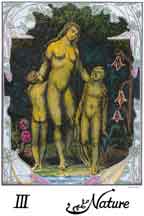 Nature
corresponds to the Empress in conventional Tarot, and is the outcome of Magic
and Mystery, of masculine energy and feminine intuition — her attribute
is emotion. Nature is symbolized here by the biblical figure of Bathsheba, King
David's favorite wife whom he took in adultery when unable to resist her beauty.
This card represents motherhood, and we see Bathsheba with the first two children
she bore to David. She gazes lovingly at her first-born son on her left (sinister)
side, the child that died as punishment for David's sin. His left foot leads
him into the water (of oblivion), and he is flanked by three lilies of sorrow.
Bathsheba's second son is on her right, with his right (spiritual) foot leading
away from the water. This is Solomon, who became the great king of Israel, and
he is flanked by three roses of glory. Both types of flowers also symbolize
the archetypal sexuality of this card, and hint at the harlot aspect of Bathsheba.
However, prostitution was anciently considered a sacred and healing activity
of the goddess.
Nature
corresponds to the Empress in conventional Tarot, and is the outcome of Magic
and Mystery, of masculine energy and feminine intuition — her attribute
is emotion. Nature is symbolized here by the biblical figure of Bathsheba, King
David's favorite wife whom he took in adultery when unable to resist her beauty.
This card represents motherhood, and we see Bathsheba with the first two children
she bore to David. She gazes lovingly at her first-born son on her left (sinister)
side, the child that died as punishment for David's sin. His left foot leads
him into the water (of oblivion), and he is flanked by three lilies of sorrow.
Bathsheba's second son is on her right, with his right (spiritual) foot leading
away from the water. This is Solomon, who became the great king of Israel, and
he is flanked by three roses of glory. Both types of flowers also symbolize
the archetypal sexuality of this card, and hint at the harlot aspect of Bathsheba.
However, prostitution was anciently considered a sacred and healing activity
of the goddess.
In Blakean iconography, the woman is Vala, the Emanation or female portion of Luvah, the eastern Zoa of Love. Luvah and Vala are associated with the art of Music because it rouses the passions; their element is Fire. Vala is the embodiment of nature, and represents, on one hand, the irresistibility of natural beauty (the feminine qualities) — and on the other hand, the danger and delusion implicit in nature (as the projection of matter). In Blake's mythology, Vala is the cause of Albion's fall, seducing him in Beulah and then giving birth to Urizen, the first-born child of the realm of Generation. Thus, in the Blakean interpretation, the child at Vala's left would be the spectrous Urizen. In her fallen form, Vala represents the illusion that the physical world is real, and her evil is that she seduces man away from true spiritual reality. Blake also calls her Babylon, the Harlot. Her 'unveiled' nakedness emphasizes both her beauty and her power: "The nakedness of woman is the work of God." The stream of water signifies the sensual aspects of nature and its creative forces. Vala as nature, like her soul-sister Hecate in II—Mystery, has three aspects: she is mother — healing and nurturing; consort — sexual and passionate; and deceiver — secretive and treacherous. As in conventional Tarot, Vala represents Isis 'unveiled', the creatrix mother of life. In the border, musical instruments and fruiting grapevines suggest the artistry and creativity associated with this card, while the communing angels emphasize the sense of pleasure that is traditionally associated with this card.
KEYWORDS: MOTHER EARTH • . MOTHERHOOD • FERTILITY • SEXUALITY • EMOTIONS • ABUNDANCE • ATTRACTIVENESS • ALSO: DECEPTION • ILLUSION •
At this stage, the soul gets emotionally involved with goddess nature, and many love-sick seekers want nothing more. For those who choose to go on...
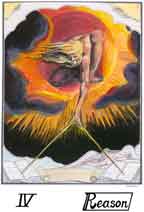 Reason
corresponds to the Emperor in conventional Tarot. It depicts the seemingly godlike
form of Urizen, who is Blake's southern Zoa of Mentality, the "eternal
mind." His name may be a multiple pun on 'reason' or 'horizon', and 'Uranus'.
Urizen, driven by self-doubt, fails to understand the need for a balance of
forces, and selfishly desires to dominate eternity. Urizen is associated with
the element Air and the art of Science, so he has a lofty ability to explain,
quantify, and manipulate reality — but Urizen is also orthodox, moralistic,
stubborn, and egotistic. He is the aspect of deity that, if unchecked, can degenerate
into Satan. Supremely dualistic, Urizen represents good intentions and blind
egotism, intellectual wisdom and implacable patriarchy, expansion and contraction,
dynamism and stasis. Wielding his compasses as a classic symbol of this dualism,
Urizen measures all things, but without compassion and true understanding. He
is the "king of pride."
Reason
corresponds to the Emperor in conventional Tarot. It depicts the seemingly godlike
form of Urizen, who is Blake's southern Zoa of Mentality, the "eternal
mind." His name may be a multiple pun on 'reason' or 'horizon', and 'Uranus'.
Urizen, driven by self-doubt, fails to understand the need for a balance of
forces, and selfishly desires to dominate eternity. Urizen is associated with
the element Air and the art of Science, so he has a lofty ability to explain,
quantify, and manipulate reality — but Urizen is also orthodox, moralistic,
stubborn, and egotistic. He is the aspect of deity that, if unchecked, can degenerate
into Satan. Supremely dualistic, Urizen represents good intentions and blind
egotism, intellectual wisdom and implacable patriarchy, expansion and contraction,
dynamism and stasis. Wielding his compasses as a classic symbol of this dualism,
Urizen measures all things, but without compassion and true understanding. He
is the "king of pride."
Like the jealous and vengeful god of the Old Testament, he is the author of absolute law, which is justice without mercy. Urizen is called the Spectre, and the adversary of spiritual consciousness. Another mocking Blakean name for him is Nobodaddy, from 'nobody's daddy'.
Sometimes associated with the sun god Apollo, Urizen is shown leaning out of the sphere of eternity into the void, in the act of measuring out what Blake calls the "mundane shell," which is the visible sky as the astral projection of the fallen world. Urizen extends his compasses downward with his left (sinister) hand, and the cosmic wind that blows his hair and beard also comes from his left.
Despite his dictatorial traits, we can also see him as the traditional Tarot figure of the kingly father who benevolently directs the actions of his subjects and children, defines limits, sets boundaries, and asserts the law.
In the border, two books of knowledge connected by a scroll of inspiration are tended by an angel who represents the holy spirit, or Comforter. These symbols have a dualistic meaning. On the one hand, they literally illustrate that truth and knowledge are linked by imagination, and presided over by love — all shown connected to Urizen through his compasses. On the other hand, these books represent Urizen's dreaded metallic books of brass (laws) and iron (war), impaled on the compass points of reason. When limited to finite perception, they deny the infinite and introduce error; when unlimited, they offer loving direction.
KEYWORDS: RATIONALITY • PATRIARCHY • AUTHORITY • REPRESSION • ORTHODOXY • ASSERTION • POSSESSION • DEFINITION • FALSE DIVINITY • SELFHOOD • DUALISM •
At this stage, consciousness realizes that it can control and define itself, wielding its intellect to create and enforce. Many seekers, fascinated with power, find it logical to stop here. For those who choose to go on...
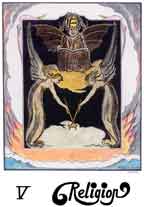 Religion
corresponds to the Hierophant in conventional Tarot. Religion is the logical
segue to reason, developing as its metaphysical counterpart. In Blake's time,
its leading form was Deism, or "natural religion," which logically
deduces the necessity of God, asserts the inborn goodness of man, and denies
the possibility of miracles or divine revelation. Deism was espoused by leading
English thinkers of the the 17th and early 18th century (and by Voltaire and
Rousseau in France, and Franklin, Jefferson, and Washington in America) —
but to Blake it was an abomination. He asserted that man's supreme faculty was
not reason but imagination — the spiritual fountain from which all true
religion flowed. In this sense, "all religions are one." But generally
speaking, 'religion' was to Blake a dirty word, referring to the spiritually
corrupt churches and preachers that he called "fiends of righteousness,"
whose moralizing was hypocritical and produced spiritual error. Moreover, Blake
believed that God (Jesus) could be personally or directly experienced through
gnosis — eliminating the need for preachers, popes, and all spiritual intermediaries.
Religion
corresponds to the Hierophant in conventional Tarot. Religion is the logical
segue to reason, developing as its metaphysical counterpart. In Blake's time,
its leading form was Deism, or "natural religion," which logically
deduces the necessity of God, asserts the inborn goodness of man, and denies
the possibility of miracles or divine revelation. Deism was espoused by leading
English thinkers of the the 17th and early 18th century (and by Voltaire and
Rousseau in France, and Franklin, Jefferson, and Washington in America) —
but to Blake it was an abomination. He asserted that man's supreme faculty was
not reason but imagination — the spiritual fountain from which all true
religion flowed. In this sense, "all religions are one." But generally
speaking, 'religion' was to Blake a dirty word, referring to the spiritually
corrupt churches and preachers that he called "fiends of righteousness,"
whose moralizing was hypocritical and produced spiritual error. Moreover, Blake
believed that God (Jesus) could be personally or directly experienced through
gnosis — eliminating the need for preachers, popes, and all spiritual intermediaries.
In this card, religion is mockingly symbolized by George III, the unpopular but long-enduring English monarch (and head of the Church of England) during both the American and French Revolutions, who eventually went insane.This image is also a political jibe, because Blake ardently (and seditiously) sympathized with the American revolutionary cause, and the early ideals of the French Revolution. Derisively called "Albion's angel" by Blake, the king is wears a papal tiara and bat wings, symbolizing the unholy collusion of church and state. Dressed both as priest and king, he sits on a Gothic throne resembling a cathedral. Like Urizen in card IV, he floats on a cloud while on his lap he holds open the book of brass (law).
The angels represent the queens of England and France who bow to natural religion, their wing tips touching the bat wings. The crossed and lowered scepters held by the angels are like Urizen's compasses; they signify worldly control and insincerity, emphasized by the serpents crawling from beneath the angels' gowns.
In the border, flames of false religion rise from the sea of time and space, chasing crowds of shamed angels to the heavens, while two crucified angels at the corners represent betrayed love and piety looking away.
Although the imagery of the card is overwhelmingly negative, it makes the statement that humanity's spiritual needs must be addressed, and thus stems from a positive impulse. Blake rejects traditional religion for being worldly and corrupt. His denunciation only underlines the importance he placed upon the influence of leaders and teachers in educating people to see the beauty and divinity of life.
KEYWORDS: SPIRITUAL NEEDS • CONVENTIONALMORALITY • TRADITION • RULES OF OBEDIENCE AND LOYALTY • FEELING BETRAYED BY THE SYSTEM • CORRUPTION OF RELIGION • TEACHING AND LEARNING •
This stage of worldly religion is unholy, but brings a sense of security to those who seek spiritual consciousness within a rational framework, convincing many seekers to righteously stop here. For those who choose to go on...
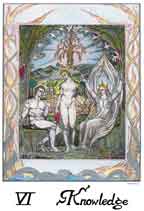 Knowledge
corresponds to the Lovers in conventional Tarot. It represents the three types
of knowledge within the human psyche: conscious, unconscious, and superconscious
— represented by the first man (Adam), the first woman (Eve), and an archangel
— in the lush garden of physical Eden. The card depicts the interrelationship
and integration of these states, which can also be called: masculine, feminine,
and divine. The archangel, with its wingtips joined as if in prayer, is Raphael
('healer of God'), who symbolizes healing and mediation. Raphael urgently dialogues
with Adam and Eve, asking them to heed the advice of God and thus be 'good'.
Eve, the central figure in the drama, submissively serves fruit and wine but
pointedly looks at Adam instead of Raphael; meanwhile Adam gestures as if to
say, 'I'm sorry, but it's out of my hands'. We know that Adam and Eve both disregard
the divine counsel, and listen instead to the serpent who girdles the 'Tree
of the Knowledge of Good and Evil' behind Eve's head.
Knowledge
corresponds to the Lovers in conventional Tarot. It represents the three types
of knowledge within the human psyche: conscious, unconscious, and superconscious
— represented by the first man (Adam), the first woman (Eve), and an archangel
— in the lush garden of physical Eden. The card depicts the interrelationship
and integration of these states, which can also be called: masculine, feminine,
and divine. The archangel, with its wingtips joined as if in prayer, is Raphael
('healer of God'), who symbolizes healing and mediation. Raphael urgently dialogues
with Adam and Eve, asking them to heed the advice of God and thus be 'good'.
Eve, the central figure in the drama, submissively serves fruit and wine but
pointedly looks at Adam instead of Raphael; meanwhile Adam gestures as if to
say, 'I'm sorry, but it's out of my hands'. We know that Adam and Eve both disregard
the divine counsel, and listen instead to the serpent who girdles the 'Tree
of the Knowledge of Good and Evil' behind Eve's head.
This card is about choice and responsibility, from which arise both individuality and maturity. In terms of biblical morality, Adam and (especially) Eve make the 'wrong' choice by committing the original sin, which is disobedience to God. But Eve's choice is motivated by a deeper understanding than dialectical reasoning or orthodox morality can comprehend. Her disobedience expresses humanity's spiritual need to gain knowledge of good and evil, of sexuality, and of the material world — in order to ultimately transcend them. Note that both Adam and Eve have their right (spiritual) feet forward, while Raphael puts its left (sinister) foot forward; Raphael also points with his left hand to heaven, while his right hand points to the forbidden tree — all these stances and gestures subliminally support the spiritual correctness of Adam and Eve's choice. The arching framework of lilies, in combination with fruiting date palms and grapevines, form the traditional symbols of paradise, while the combination of roses and lilies at the corners represents innocent love.
Knowledge is the true start of the revolution that will eventually overthrow natural religion and lead the soul back to eternity. To Blake, the downside of Eve's choice is that her action usurps God's power to judge good and evil, thus creating the system of human justice with its terrible error of vengeance. However, Blake also maintained that error always has value because it exposes what needs to be corrected.
In the border, the serpent god Leviathan writhes upon the sea of time and space, intertwining with the rising spirals of flames and briars while angels at the upper corners look down and wonder. This complex combination of symbols represents both sin and the burning-up of sin, both death and rebirth, and the interplay of matter and spirit as an ornately beautiful drama.
KEYWORDS: SELF-KNOWLEDGE • SELF-INTEGRATION • CLARIFYING AND MAKING CHOICES • TAKING RESPONSIBILITY • MORAL FREEDOM • CARNAL KNOWLEDGE • MARRIAGE • INFLUENCE OF OTHERS •
Knowledge brings self-satisfaction, along with many dangers. Consciousness now realizes the potential for its own divinity, and learns about ecstasy. Many seekers stop here to enjoy the physical fruits of Eden. For those who choose to go on...
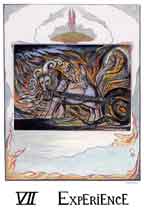 Experience
corresponds to the Chariot in conventional Tarot. It represents the culmination
of the material quest, completing the stages of the Cycle of Matter. In this
card, the bizarre and flame-girded vehicle represents the fleshly chariot of
experience persevering in the hellish world of matter. With wheels and traces
formed of three serpents, drawn by two oxen with the manes of lions and faces
of men with spiral horns, upon whose backs are gnome-like eagles, here is a
strange but appropriate symbol of all the contradictory and monstrous forces
ruling the fallen world at the end of its cycle of material evolution. Humanity,
represented by the aged and weary couple riding the chariot, is physically and
spiritually spent within a burnt landscape. This is Adam and Eve at the end
of their worldly journey, having started with high hopes in the physical Eden
and now come to the last stage of Generation, Blake's vegetative realm. Here,
"life lives upon death & by devouring appetite all things subsist on one
another."
Experience
corresponds to the Chariot in conventional Tarot. It represents the culmination
of the material quest, completing the stages of the Cycle of Matter. In this
card, the bizarre and flame-girded vehicle represents the fleshly chariot of
experience persevering in the hellish world of matter. With wheels and traces
formed of three serpents, drawn by two oxen with the manes of lions and faces
of men with spiral horns, upon whose backs are gnome-like eagles, here is a
strange but appropriate symbol of all the contradictory and monstrous forces
ruling the fallen world at the end of its cycle of material evolution. Humanity,
represented by the aged and weary couple riding the chariot, is physically and
spiritually spent within a burnt landscape. This is Adam and Eve at the end
of their worldly journey, having started with high hopes in the physical Eden
and now come to the last stage of Generation, Blake's vegetative realm. Here,
"life lives upon death & by devouring appetite all things subsist on one
another."
The strange creatures pulling the chariot lead with their left feet, and yet their spiral horns are crowned with laurel wreaths of victory — a traditional meaning of this card. As distorted forms of the Zoas (recognizable by their features of ox, lion, man, and eagle), their powers throughout the journey so far have won many material victories and conquests, which are evident in their harsh but human faces. Materialism, which is Generation, does offer protections and comforts for those who strive. Its mills have subjugated nature and its consciousness has even expanded into "twofold vision," which is Blake's term for the perception of human values.
Although acknowledging success on the material plane, this card emphatically shows the ultimate victory to be Satan's and not Humanity's. Still, Experience is a necessary phase on the way to regeneration. One of the mysterious hands at the tips of the spiral horns reaches back for the eagle-gnome's pen (at the center of the image) — a sign that the poetic imagination (of which the pen, eagle, and gnome are all symbols) is still functioning, and the other hand may yet redirect the chariot and bring new life to its passengers.
In the border, a bat-winged Satan stands in mastery over the globe, sword in his left hand, looking back over the Cycle of Matter, well satisfied with his handiwork so far. Stricken angels lie upon the corners, and flames and thunderbolts lick at the lower edges of the card, signifying major turmoil. Is this defeat or cleansing?
KEYWORDS: MATERIAL POWERS • MATERIAL VICTORY • SPIRITUAL DEFEAT • AMBIGUITY • MATURITY • COMPLETED DEVELOPMENT • WORLDLINESS • CONTROL OVER NATURE • CONTROL OVER INSTINCTS AND EMOTIONS • EGO-CONCERNS •
The seeker who is pleased with material success may well stop here. The majority of mankind is content within Satan's mastery of this first cycle. Yet, for those who choose to go on, a breakthrough is in store...
The second cycle, with its seven cards in which the soul becomes aware of spiritual reality, now begins...
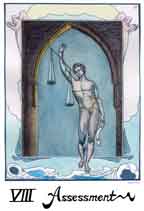 Assessment
corresponds to Justice in conventional Tarot. Initiating the Cycle of Awakening,
this card addresses the need for personal reconsideration as the first step
in the process of spiritual regeneration. It questions whether and how the damaged
soul can continue its journey. A key aspect of the naked man — who represents
compassion, not justice — is that the traditional sword of vengeance is
replaced by a scroll of imagination. This concept is revolutionary because it
imaginatively replaces judgement with forgiveness. Furthermore, the scales that
Assessment raises with his right hand are not evenly balanced (as always portrayed
in other decks), but clearly weighted in the direction of the scroll. This symbol
means: Be imaginative! Forgive yourself and others! Judge not according to man's
justice but according to divine inspiration and love!
Assessment
corresponds to Justice in conventional Tarot. Initiating the Cycle of Awakening,
this card addresses the need for personal reconsideration as the first step
in the process of spiritual regeneration. It questions whether and how the damaged
soul can continue its journey. A key aspect of the naked man — who represents
compassion, not justice — is that the traditional sword of vengeance is
replaced by a scroll of imagination. This concept is revolutionary because it
imaginatively replaces judgement with forgiveness. Furthermore, the scales that
Assessment raises with his right hand are not evenly balanced (as always portrayed
in other decks), but clearly weighted in the direction of the scroll. This symbol
means: Be imaginative! Forgive yourself and others! Judge not according to man's
justice but according to divine inspiration and love!
The numbering of Assessment as VIII instead of XI corresponds to Marseilles-style decks rather than decks using the Waite-Smith variant, in part for historical correspondence with decks of Blake's period.
In the Blakean interpretation, this represents Luvah, the Zoa of Emotion. His name is a pun on 'Lover'. In III—Nature, we met Vala as his fallen Emanation. Now, in this card Luvah himself appears as the loving and compassionate instigator of spiritual regeneration. Luvah, the "prince of love," is frequently associated by Blake with Jesus, who in turn represents forgiveness and imagination — both of which are necessary for the soul's breakthrough into the later Cycle of Awakening. Luvah walks naked in beauty upon the empty shells of men's souls abandoned on the materialistic shore of the sea of time and space. He steps through a Gothic gateway symbolizing spirit, inviting us to go further along the soul's journey. There is no veil or hindrance at the gate; its transparency is the freedom of the spirit to choose its own way.
In the upper border, recording angels note the choices made, and eagles below symbolize the imagination; the clouds are the spiritual body of Humanity.
KEYWORDS: SPIRITUAL REALIZATION • IMAGINATIVE DECISIONS • THINGS NOT IN EQUILIBRIUM • WEIGHING INTANGIBLES • CONCERN WITH BEING FAIR OR JUST • INSPIRED NEGOTIATIONS • FORGIVENESS OF SELF AND OTHERS • MORAL SITUATIONS •
Seekers who are complacent or satisfied can go no further, and sink down to join the skeletal shells. For those who choose to go on...
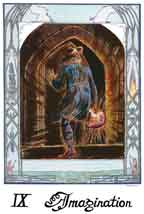 Imagination
corresponds to the Hermit in conventional Tarot. Here is the light that illuminates
life in its innermost depths and mysteries. We see a hermit-like figure with
a globe of holy fire entering a doorway and peering into the darkness. We can
fearlessly face the unknown to find our spiritual selves, using divine imagination
as our guide.
Imagination
corresponds to the Hermit in conventional Tarot. Here is the light that illuminates
life in its innermost depths and mysteries. We see a hermit-like figure with
a globe of holy fire entering a doorway and peering into the darkness. We can
fearlessly face the unknown to find our spiritual selves, using divine imagination
as our guide.
The figure is Los, who first appeared in I—Magic. Los is Blake's mythic personification of Urthona, the Zoa of Imagination. The name Los is the inverse of Sol, which means 'Sun', and is the homonym of 'Soul'. Thus Los 'mirrors' both the sun and soul. In card I, Los as time is part of the Cycle of Matter as the fallen magus who manipulates matter. Now, in the Cycle of Awakening, Los assumes his heroic role as the "prophet of eternity," the living force of imagination that provides the means to reunify Albion. Blake figuratively shouted in all his works that imagination is the most vital faculty of both man and god, and is therefore the vital link between them. We dream God and God dreams us. More than that, imagination is god within man, and is the only god. "Man is all imagination: God is man & exists in us & we in him." —————[god or God??? him or Him???]——————
In this card, Los is clothed as a night watchman, prudently wearing a work coat, felt hat, and sandals — the search for truth is garbed in simplicity and humility. Los's left hand, having pushed open the door, is raised as if in recognition. Perhaps he sees the isolation and introspection he must experience during the journey. In his right hand, "the red globule is the unwearied sun by Los created, [the]...light of light." He steps (with his right foot) through a doorway into what seems a dark tomb, the death of materialism that is the gateway to eternity. Los's hair is blown back by the breath of spiritual life invisibly flowing toward him, and like Luvah's gateway in the previous card, LosÕs doorway is of Gothic design — the "living form" of the true church: the Ageless Wisdom.
In the border, two spiraling ladders of symbols recapitulate the path of consciousness from bottom to top: The pastoral innocence of the lambs and their shepherds gives way to the vanity of the peacock (left) and the mimicry of the parrot (right). Above them come a series of larks in their nests, which in Blake's system symbolize new ideas. Then these ideas must be tested in smoke and fire, signifying pain and suffering that make the angels weep. Persevering higher, at last come the living Gothic arches that vault to heaven through clouds of divinity. The entire border design itself forms a Gothic arch that frames the central motif. Imagination is the grand gate that connects man to the divine, for it rests on earth and arches to heaven.
KEYWORDS: UNLIMITED IMAGINATION • INTROSPECTION • INNER CONVICTION • PASSAGE OF TIME • TIMING • THE INNER TEACHER • OCCULT WISDOM • SPIRITUAL JOURNEY • FACING THE UNKNOWN • SELF-GUIDANCE • PREPARATION AND PRUDENCE • DEATH OF THE EGO-SELF •
For seekers without imagination, the danger is too great, and they dare not step through the door. For those who can imagine going further...
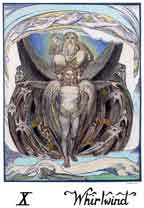 Whirlwind
corresponds to the Wheel of Fortune in conventional Tarot. It signifies change,
and reveals reality to be a whirlpool of energy in which anything can happen.
Unlike fortune or fate, Whirlwind is a guided spiritual force that activates
the Zoas or eternal forces within man, now for regenerative purposes. Ezekiel
in the Bible says, "I looked, and, behold, a whirlwind came out of the
north." The north is associated with Los. It is he who unleashes the cyclone,
the soul-twister that stirs up when man's true potential for divinity is revealed.
Within the whirlwind are the four 'beasts' of the Book of Revelation —
the highest cherubim, the 'living creatures' witnessed by the prophets. In their
fourfold nature, they bear the faces of the ox, lion, man, and eagle Š the tetramorphs
of. the four Zoas. "These are the four faces towards the four worlds...in
every man." The card image does not depict the animal faces, illustrating
instead the biblical lines: "They four had one likeness: and their appearance
and their work was...a wheel in the middle of a wheel...full of eyes round about
them four."
Whirlwind
corresponds to the Wheel of Fortune in conventional Tarot. It signifies change,
and reveals reality to be a whirlpool of energy in which anything can happen.
Unlike fortune or fate, Whirlwind is a guided spiritual force that activates
the Zoas or eternal forces within man, now for regenerative purposes. Ezekiel
in the Bible says, "I looked, and, behold, a whirlwind came out of the
north." The north is associated with Los. It is he who unleashes the cyclone,
the soul-twister that stirs up when man's true potential for divinity is revealed.
Within the whirlwind are the four 'beasts' of the Book of Revelation —
the highest cherubim, the 'living creatures' witnessed by the prophets. In their
fourfold nature, they bear the faces of the ox, lion, man, and eagle Š the tetramorphs
of. the four Zoas. "These are the four faces towards the four worlds...in
every man." The card image does not depict the animal faces, illustrating
instead the biblical lines: "They four had one likeness: and their appearance
and their work was...a wheel in the middle of a wheel...full of eyes round about
them four."
Above is God on his throne, with his right arm upraised in blessing or greeting. Although the Old Testament god is depicted, in Blake's system God is Jesus — and Man — and Imagination: "The eternal body of man is the imagination; that is, God himself, the divine body, Jesus: we are his members." In this sense, God is a universal symbol for our own divinity. The starry eyes whirling within the wheels may be the "members," who are us. Or the eyes are the ideas of the soul, whirling with holy energy.
In the upper border, the Eyes of God shape the wheel of the whirlwind, and crown God- Jesus-Man-Imagination with an angelic halo that is itself a metaphor of man's spiritual evolution. At the base of the border, we see the forest of error felled by the force of impending change, while Ezekiel ('God strengthens') gazes up in wonder.
KEYWORDS: CHANGING CIRCUMSTANCES • CYCLES AND TURNING POINTS • CIRCULAR THINKING • SHIFTS OF FORTUNE • GATHERING OF RESOURCES • THE DANCE OF LIFE • NEW OPPORTUNITIES • WHIRLING IDEAS • CHANGES OF SEASONS • SPIRITUAL CELEBRATION •
The vision of the fourfold forces is awesome to behold, and many seekers stop here in dizziness from the sight. For those who choose to go on...
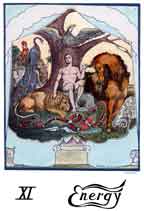 Energy
corresponds to the Strength card in conventional Tarot. It symbolizes the stage
of physical renewal, as inner strength arising from the body itself, and from
animal intuition at the deepest level. The forms of the Zoas are again depicted;
they are even arranged in their proper symbolic order: the ox of Tharmas at
the left of the tree (west), the lion of Urizen at the base (south), the man
of Luvah in front (east), and the eagle of Urthona above (north) — see
Chart 2-2. The symbolic reappearance of the Zoas here emphasizes that Energy
is both the outcome and the continuity of Whirlwind. That they are arrayed around
the oak tree signifies the strength and endurance of the energy of nature.
Energy
corresponds to the Strength card in conventional Tarot. It symbolizes the stage
of physical renewal, as inner strength arising from the body itself, and from
animal intuition at the deepest level. The forms of the Zoas are again depicted;
they are even arranged in their proper symbolic order: the ox of Tharmas at
the left of the tree (west), the lion of Urizen at the base (south), the man
of Luvah in front (east), and the eagle of Urthona above (north) — see
Chart 2-2. The symbolic reappearance of the Zoas here emphasizes that Energy
is both the outcome and the continuity of Whirlwind. That they are arrayed around
the oak tree signifies the strength and endurance of the energy of nature.
All the animals in this card represent instincts and intuitions that are mediated and mastered by the human figure of Tharmas, the Zoa of Body. Tharmas is shown filled with the renewed energy of life, and this "energy is eternal delight." The original inscription to this illustration says of the animals, "Their strength, or speed, or vigilance, were giv'n in aid of our defects" (William Hayley) — in other words, the animal forces are our allies.
More than that, however, Tharmas is the ally of the animal forces; that is, he is the means through which they 'speak' — and in this sense, this card is also about the energy inherent in metaphor. Tharmas, whose sense organ (Chart 2-2) is the tongue, assumes the qualities of the animals by speaking for them. Because the first function of speech is the communication of the soul, the animals are metaphors for the range and power of the multidimensional human soul. (In metaphor, saying 'I am a lion' makes me a lion and personifies its qualities within me; by contrast, allegory says 'I am like a lion' and thus means I am not really a lion and only pretending. Metaphor releases energy, while allegory weakens it.)
Traditional to this card, the lion is featured, and reclines at man's feet to signify that its fabled strength is under his command, and he can draw on it at will. Note also that Tharmas's symbolic animal (Chart 2-2) is the ox of strength and patience, which appears at the lower left; and in reference to his calling as a shepherd, the ram of virility appears at the lower right. In speaking for the animals Tharmas demonstrates that he understands (and loves) his bodily instincts and physical capabilities, and they listen to his dictates.
This card marks the midway point of the soul's journey, and so it repeats the border motifs of card I to symbolize a new beginning through the second decanate of cards.
KEYWORDS: LUST FOR LIFE • SENSUAL DELIGHT • ABUNDANCE OF VITAL ENERGY • INTEGRATION OF CAPABILITIES AND INSTINCTS • PHYSICAL ENDURANCE AND COURAGE • MULTIDIMENSIONALITY. METAPHORIC EXPRESSION •
A strong sense of animal satisfaction may lull many seekers into stopping here. For those with the energy to go further...
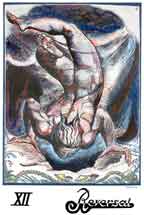 Reversal
corresponds to the Hanged Man in conventional Tarot. This card represents the
upset of reason and the reversal of old views. Urizen, the Zoa of Mind, limited
by pride and error, is the last of the Zoas to reappear in the Cycle of Awakening
as part of the process of regeneration. He must do something radical, yet still
act within his nature: thus this handstand of the soul. Both active and passive,
it is a creative expression and synthesis of Urizen's dualism. The Tarot Hanged
Man is passive and defenseless in his suspension. By contrast, the regenerate
figure of Urizen now uses the metaphoric strength acquired in XI—Energy
to position the soul into dynamic balance instead of mere suspension. His pose
is physically static, but its sense of contained energy is wonderfully dynamic.
In this prelude to Transformation, the soul chooses to reverse and reinvent
itself, rather than be controlled by nature anymore.
Reversal
corresponds to the Hanged Man in conventional Tarot. This card represents the
upset of reason and the reversal of old views. Urizen, the Zoa of Mind, limited
by pride and error, is the last of the Zoas to reappear in the Cycle of Awakening
as part of the process of regeneration. He must do something radical, yet still
act within his nature: thus this handstand of the soul. Both active and passive,
it is a creative expression and synthesis of Urizen's dualism. The Tarot Hanged
Man is passive and defenseless in his suspension. By contrast, the regenerate
figure of Urizen now uses the metaphoric strength acquired in XI—Energy
to position the soul into dynamic balance instead of mere suspension. His pose
is physically static, but its sense of contained energy is wonderfully dynamic.
In this prelude to Transformation, the soul chooses to reverse and reinvent
itself, rather than be controlled by nature anymore.
Reversal also has the meaning of undergoing a reverse; that is, being upset or overthrown, suffering defeat, loss, or depression. In this possibility, we see the soul swept off its feet and clinging to retain balance while being buffeted by the winds of change and personal challenge. Archetypal psychologist James Hillman has defined the soul's ability to create abnormality, suffering, and illness as pathologizing. Although frightening, this ability is necessary because we can reach the gods through affliction. This situation represents an opportunity to regenerate the soul by seeing things differently, especially to find new meanings and get closer to the underlying spiritual basis of the matter. Blake said that "every natural effect has a spiritual cause." Therefore anything that helps us see the cause is beneficial.
In the lower border, various malevolent symbols — toadstools (death), thorns (pain), thistles (uselessness), and lily of the valley (poison) — are unavoidably exposed to the seeker in the midst of his upside-down adventure, while raindrops or tears drip from the clouds beside his hands. Like much else in this card, these are ambiguous symbols whose meaning can only be determined in context. They could be interpreted as departing aspects of the forlorn material world, difficulties or pathologizing being experienced in the present situation, or harbingers of worse things just ahead in the future.
KEYWORDS: REVERSAL OF THE ESTABLISHED ORDER • COMMUNING WITH THE INNER SELF • UNCONVENTIONALITY • RITE OF PASSAGE OR INITIATION • CHAOTIC MEDITATION • PSYCHIC ISOLATION • MYSTICISM • DEFEAT, MARTYRDOM, SELF-PITY • PATHOLOGIZING AS AWAY OF COMMUNICATINGWITH SPIRIT •
This contrary exercise is enough to dissuade many seekers, who choose to suspend things here. For those who can face going further...
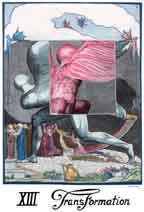 Transformation
corresponds to Death in conventional Tarot. It represents the impermanence of
materialistic consciousness, and the prospect of imminent transformation —
one way or the other. Before the soul can return to eternity, the concerns of
the material self must be cut away, if not by choice than by time itself. This
card signifies a major change in consciousness, necessary at this point in the
journey. Change is inevitable in any case, and the vegetative world is a hopeless
cause — "the grave is heaven's golden gate, and rich and poor around
it wait." The demise of one thing is the dawning of something else. Energy
cannot be destroyed, only transformed. The release of energy previously imprisoned
in old forms endows this process with great drama and power. However, this card
is primarily a metaphor for mystical, not physical, death — it points to
the need for transforming oneself during this lifetime, beginning with this
moment, as an essential step in the process of spiritual initiation.
Transformation
corresponds to Death in conventional Tarot. It represents the impermanence of
materialistic consciousness, and the prospect of imminent transformation —
one way or the other. Before the soul can return to eternity, the concerns of
the material self must be cut away, if not by choice than by time itself. This
card signifies a major change in consciousness, necessary at this point in the
journey. Change is inevitable in any case, and the vegetative world is a hopeless
cause — "the grave is heaven's golden gate, and rich and poor around
it wait." The demise of one thing is the dawning of something else. Energy
cannot be destroyed, only transformed. The release of energy previously imprisoned
in old forms endows this process with great drama and power. However, this card
is primarily a metaphor for mystical, not physical, death — it points to
the need for transforming oneself during this lifetime, beginning with this
moment, as an essential step in the process of spiritual initiation.
In this collaged card, we see two aspects of time, combined at the hip in the form of a rather grotesque angel. Its blue persona holds "time's enormous scythe, whose ample sweep strikes empires from the root," harvesting the life of the past. Loss must always precede the coming rebirth. Simultaneously, time's lively red persona, wings raised high, looks the other way — into the future and new life. The people shown in the card are the same as those depicted in 10 of Painting, and most are oblivious to their fate.
In the lower border, the thistles in the previous card are now joined by various remnants of defeated humanity and artifacts of hard times: the sheephook of innocence is fractured by the march of time, the pitcher of life broken by time's scythe, and the overgrown fountain of fertility abandoned to frogs and the locust's scourge. Overhead, bat-winged angels cavort in the clouds, while others at the sides dangle spiders from threads of fate. There is no escape from the decay of worldly things, except through transformation into a new regime of belief.
KEYWORDS: UPROOTING OF LIFE • CHANGE. CHANGE OF CONSCIOUSNESS • PRUNING AND CUTTING AWAY • INTENSE EXPERIENCE • GETTING BACK TO BASICS • ELIMINATION. LETTING GO • SURRENDER •
Those unable to accept the pain of new beliefs, who would rather endure the pain of their dying beliefs, now give up the ghost right here. Those who can accept going further find that surrender brings renewal...
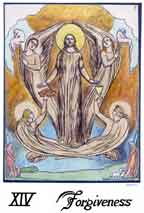 Forgiveness
corresponds to Temperance in conventional Tarot. It represents the quality of
mercy depicted as Jesus, who now appears as the soul's guide through the infernal
regions yet to come. Jesus is Blake's symbol for the human imagination, the
divine power in man. To Blake, Jesus is not a religious or church figure, but
the personification of an idea. Forgiving error in oneself and others is an
idea so creative and powerful that most people cannot even imagine it. Forgiveness
has far-reaching implications in both everyday and artistic life — because
if you do not forgive others you cannot know the feeling of true joy; if you
do not forgive yourself, you cannot function as an individual. Forgiveness is
imagination in action. It is the root and the vine of all healing, the place
of communion with all that is holy.
Forgiveness
corresponds to Temperance in conventional Tarot. It represents the quality of
mercy depicted as Jesus, who now appears as the soul's guide through the infernal
regions yet to come. Jesus is Blake's symbol for the human imagination, the
divine power in man. To Blake, Jesus is not a religious or church figure, but
the personification of an idea. Forgiving error in oneself and others is an
idea so creative and powerful that most people cannot even imagine it. Forgiveness
has far-reaching implications in both everyday and artistic life — because
if you do not forgive others you cannot know the feeling of true joy; if you
do not forgive yourself, you cannot function as an individual. Forgiveness is
imagination in action. It is the root and the vine of all healing, the place
of communion with all that is holy.
Blake's view of the historical Jesus disagrees with the Christian version. A lifelong Bible scholar, Blake stated that Jesus was a bastard who died a hopeless sinner. He criticized Jesus's politics and labeled the resurrection a lie. Nevertheless, Blake was profoundly inspired by Jesus's idea of forgiveness of sin, for it repudiated the pernicious laws of Mosaic morality, eliminated the necessity of war and violence, and rendered the judgement of good and evil irrelevant.
Forgiveness conceptually incorporates Temperance — as in the traditional card of that name. Dealing with matters in a moderate or proportionate way (temperance) is suggested here by Jesus's hands extending over the "ambrosial fruits fetched from the tree of life" (bread) and "ambrosial drink from the fount of life" (wine) offered by angels below. It also refers to strengthening or toughening, with the fire of the sun providing spiritual tempering. And it relates to mental disposition or temperament, exemplified by the angelic choirs.
In the border, the shepherds at the corners and the small angels above suggest patience at this time. Forgiveness has the power to cast out all error. It takes Transformation a step further into the alchemical transubstantiation of bread and wine into body and blood.
KEYWORDS: CREATIVE SOLUTIONS • COMPASSION • HEALING AND BEING HEALED • WORKING WITH AN INNER GUIDE • MANAGEMENT OF RESOURCES • BLENDING AND HARMONIZING • PROPORTION AND TIMING. ALCHEMICAL ARTS. RENEWAL •
Needy of forgiveness, many souls linger here to feel safe. For those who can accept going further, here is the key that unlocks the next cycle...
Having now been tossed, turned, transformed, forgiven, and tempered, the soul may justly feel satisfied that spiritual awareness has been achieved. However, the most difficult stages are yet ahead, as the final Cycle of Spirit begins...
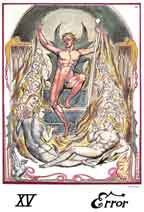 Error
corresponds to the Devil in conventional Tarot. It introduces what is traditionally
called the Dark Night of the Soul, where Satan ("the prince of this world")
appears within oneself as selfhood ("reasoning and doubting"), which
Blake equated with spiritual fear. The soul sinks into Ulro, Blake's term for
the lowest point in material existence, a state of "deepest night [and]
dread sleep [filled with] unreal forms...productive of the most dreadful consequences...
even of torments, despair, eternal death." It is at this point in the journey,
just when the soul is finally releasing itself from its old beliefs, that error
reasserts itself in primal ferocity. In these dark regions, Satan — who
is a state of mind, not a being — declares his egotism: "I am God
alone: there is no other." He uses fear and ignorance to keep the seeker
in the state of "opacity," blocking the light of imagination and mercy,
the true gods within oneself. To Blake, error represents the delusions of materialism
and worldly morality that engulf the individual in darkness. Error tries to
negate Forgiveness.
Error
corresponds to the Devil in conventional Tarot. It introduces what is traditionally
called the Dark Night of the Soul, where Satan ("the prince of this world")
appears within oneself as selfhood ("reasoning and doubting"), which
Blake equated with spiritual fear. The soul sinks into Ulro, Blake's term for
the lowest point in material existence, a state of "deepest night [and]
dread sleep [filled with] unreal forms...productive of the most dreadful consequences...
even of torments, despair, eternal death." It is at this point in the journey,
just when the soul is finally releasing itself from its old beliefs, that error
reasserts itself in primal ferocity. In these dark regions, Satan — who
is a state of mind, not a being — declares his egotism: "I am God
alone: there is no other." He uses fear and ignorance to keep the seeker
in the state of "opacity," blocking the light of imagination and mercy,
the true gods within oneself. To Blake, error represents the delusions of materialism
and worldly morality that engulf the individual in darkness. Error tries to
negate Forgiveness.
In this card, we see that error is not in the individual alone. Satan counsels here with his numberless potentates, demonian spirits, and powers of the elements. Girded with flames, he speaks about how to tempt and defeat imagination (Jesus); that is, the divine spirit of forgiveness within man. Satan's accomplices represent all the forces in society that readily reinforce and propagate error, the vast support system for the false god who deludes the individual at every step. Today these forces include the media, governments, corporations, and other civil organizations that promote violence, immorality, materialism, and stupidity. In the card, Satan's left (materialistic) hand holds his phallic scepter of sovereignty over the flesh, and with his left foot elevated, his right hand mockingly makes the chironome (hand-sign) of the horned phallus. The spears at left and right represent deadly powers, while the single spear held by the foreground figure on the right is a weapon against mercy, reminding us that Jesus was pierced with a spear. A female spirit at the left wears a net that symbolizes the snare of sex as another of Satan's weapons (Compare this card to VI—Knowledge, its traditional analogue, VI being the numerological reduction of XV.)
In the border, souls at the upper corners struggle to ascend or just hold on, but are held back by bat-wings of delusion and chains of selfhood, even though they are not fastened to anything. Beneath, we see a raven treading on a serpent and an owl grasping a mouse, flanking two scrolls. These symbols of mortality and superstition can devour the imagination.
KEYWORDS: SELFISHNESS • PRIDE. EGO • IGNORANCE AND FEAR • GUILT AND TEMPTATION • BOUNDARIES AND LIMITATIONS • SELF-IMPORTANCE AND LACK OF COMEDY • OBSESSION WITH SEX, WEALTH, AND POWER • TRAPPED IN MATERIALISM • INNER PANIC AND PANDEMONIUM •
The path here is treacherous and requires focused attention upon the truth. Many souls cannot find it in themselves, and give up here. For those who can accept going further...
 Lightning,
which continues the Dark Night of the Soul, corresponds to the Tower in conventional
Tarot. It illustrates the biblical story of the destruction of Job's sons (on
the right) and their wives (on the left). Their sins include adultery and dissipation
(the concubine lying below, with timbrel and lyre) and gluttony (the goblet
and plates at lower right). Job does not yet realize the Accuser is in his own
mind, and that the god he selfrighteously worships is actually Satan —
his own pride. In Blake's myth, Satan also represents the evil that can result
from unrestricted rationality, when Urizen (Zoa of Reason) degenerates into
the Spectre (unimaginative mind). An example of the Spectre is today's scientific
community, which society worships as a false god, a deification of reason that
creates terrific spiritual error.
Lightning,
which continues the Dark Night of the Soul, corresponds to the Tower in conventional
Tarot. It illustrates the biblical story of the destruction of Job's sons (on
the right) and their wives (on the left). Their sins include adultery and dissipation
(the concubine lying below, with timbrel and lyre) and gluttony (the goblet
and plates at lower right). Job does not yet realize the Accuser is in his own
mind, and that the god he selfrighteously worships is actually Satan —
his own pride. In Blake's myth, Satan also represents the evil that can result
from unrestricted rationality, when Urizen (Zoa of Reason) degenerates into
the Spectre (unimaginative mind). An example of the Spectre is today's scientific
community, which society worships as a false god, a deification of reason that
creates terrific spiritual error.
Lightning has a dual interpretation: On one hand, this is a vision of hell in which we see our own inner guilt projected as Satan, vengefully punishing our failures but simultaneously devastating our human qualities and family values. However, the scene is illuminated by a lightning flash of insight — allowing us to penetrate the darkness and suddenly realize that the Accuser is our own self-doubt. "I in my selfhood am that Satan: I am that evil one," declares the enlightened soul. The flash of lightning is also a pun on 'light'ning'; that is, the lightening of the 'dark night of the soul'. Healing oneself can now take place through forgiveness, an imaginative act that banishes accusation and prefigures divinity.
Alternatively, all the figures in the card can be considered en masse to represent a state of error, a neurotic psychological structure still the same hell of our own making. Merely illuminating this shaky edifice of ego brings it crashing down. Taking responsibility for our own suffering is the electric idea that strikes Satan from behind, shattering his dominion and collapsing the tower of ego and its errors within. This depicts the sacrifice of selfish beliefs, which can stimulate pain and anger, even though necessary. The flames symbolize the old errors burning away and liberating energy for a new life.
The collapsing temple is of post-and-lintel design, denoting Blake's Druidic or false religion. Satan hands are outspread in mock divinity. At his feet, Job's eldest son balances on a staircase of spirit, and tries to save his wife (love) and child (innocence) but his efforts are futile. At the lower right, one son in death mimics the Tarot Hanged Man in martyrdom. In the border, the scorpions and the serpent's scales, the dark clouds and licking flames — all identify this as the Spectre's domain. But steps at left and right show the potential for spiritual elevation — and there is fresh new growth appearing at the the base of the tower. In this card the state of error is personal, whereas in the previous card it was societal.
KEYWORDS: THE BREAK-UP OF RIGID STRUCTURES • SPIRITUAL AWAKENING • A BOLT OF INSIGHT FROM ABOVE. PURIFICATION • LIBERATION AND RELEASE • UNEXPECTED CHANGES • DISASTER • HUMILIATION • SHATTERED RIGIDITY AND CRYSTALLIZATION • RELEASED ANGER •
Some seekers are afraid of the light'ning, and stay here with the dark wreckage of their lives. For those who can accept more light...
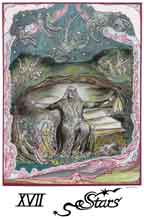 Stars
corresponds to the Star in conventional Tarot. The light of the astral intelligences
reveals the path once again; the worst of the darkness is over. The soul's inner
eye now opens to the grandeur of eternity's firmament. This card depicts the
poet John Milton (whose epic Paradise Lost starred and made Satan famous at
the time) communing with the constellations from his underground bower of poetry.
Although Milton in his old age is completely blind and subterranean, his mind
sees and communicates perfectly with the divine energies of the universe. With
his arms and fingertips upraised as if absorbing energy, he glows in gnostic
ecstasy.
Stars
corresponds to the Star in conventional Tarot. The light of the astral intelligences
reveals the path once again; the worst of the darkness is over. The soul's inner
eye now opens to the grandeur of eternity's firmament. This card depicts the
poet John Milton (whose epic Paradise Lost starred and made Satan famous at
the time) communing with the constellations from his underground bower of poetry.
Although Milton in his old age is completely blind and subterranean, his mind
sees and communicates perfectly with the divine energies of the universe. With
his arms and fingertips upraised as if absorbing energy, he glows in gnostic
ecstasy.
At his left (intellectual) arm is his book of knowledge and lamp of imagination; while at his right are the spirits of herbs and flowers, as well as symbols of human love. At the bottom left, lilies and roses are personified by two pairs of figures: in one, a hovering woman resurrects another from the earth; and a dancing couple embrace beneath an arch of baby angels, signifying perfect love. Underneath the book, a reclining mother nurses her twins. All these figures symbolize and express his inner vision as he speaks his poetic prophecies. By contrast, above him on the surface we see many other people beseeching the stars, but being spiritually blind they can only wail in frustration. Without inspiration, they fail to understand that what they desire from the stars is within them, and not beyond reach above them.
This scene illustrates the final lines of Milton's Il Penseroso:
And may at last
my weary age
Find out the peaceful hermitage
The Hairy Gown and Mossy Cell
Where I may sit and rightly spell
Of every Star that Heaven doth shew
And every Herb that sips the dew
Till old experience do attain
To something like Prophetic strain
When Blake painted this picture, he too was approaching old age, and so it can be seen as a psychic self-portrait showing Blake in his own cave of creation, filled with love and writing inspired books of prophecy, while his contemporaries seek but fail to grasp his vision.
In the border below, another aged figure about to awaken. This is the biblical Job represented as sleeping Humanity, with his hand resting on a scroll of inspiration. Streams of angels urge him to open his inner eyes and soar together with them, weaving through the constellations, upward into inspiring visions of eternity.
KEYWORDS: SPIRITUAL REGENERATION • ENDLESS INSPIRATION • MULTIDIMENSIONAL PERCEPTION • CLAIRVOYANCE • NATURE WORSHIP • PUBLIC RECOGNITION • SELF-ESTEEM • ALTRUISTIC IMPULSES AND DESIRES • LIVING YOUR OWN VALUES •
The inspiration of the night sky is heaven enough for many star-struck seekers, who are content to stay here. For those whose opened eyes can accept the vision of even more...
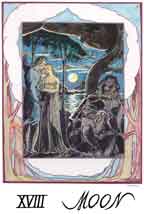 The
Moon corresponds to the card of the same name in conventional Tarot. It sheds
the light of lunar understanding upon a beautiful but perilous stage in the
path. The Moon represents the use of the subconscious mind for intuition, dreams,
and creativity — going inside yourself using what Blake calls "threefold
vision," a type of perception that fuses thoughts and feelings. In the
card we a family of pilgrims beside a moonlit bay, endangered by a pair
of "fiends" hidden in the darkness. This scene is Blake's realm of
Beulah, ruled by Luvah and the emotions — a state of spiritual repose,
artistic creativity, and open sexuality. Beulah, a place of perpetual night
illuminated by the moon, specifically represents the dream world in which contraries
such as peace and danger are equally true — a description of the subconscious
mind. In dreams, the soul tells its tale without the censorship of the ego,
and thus we can learn about our own psychic realities.
The
Moon corresponds to the card of the same name in conventional Tarot. It sheds
the light of lunar understanding upon a beautiful but perilous stage in the
path. The Moon represents the use of the subconscious mind for intuition, dreams,
and creativity — going inside yourself using what Blake calls "threefold
vision," a type of perception that fuses thoughts and feelings. In the
card we a family of pilgrims beside a moonlit bay, endangered by a pair
of "fiends" hidden in the darkness. This scene is Blake's realm of
Beulah, ruled by Luvah and the emotions — a state of spiritual repose,
artistic creativity, and open sexuality. Beulah, a place of perpetual night
illuminated by the moon, specifically represents the dream world in which contraries
such as peace and danger are equally true — a description of the subconscious
mind. In dreams, the soul tells its tale without the censorship of the ego,
and thus we can learn about our own psychic realities.
The figures lurking in the shadows, behind the rock beneath the Druidic oak, are the enemies of intuition — the twin fiends of reason and morality, the forces of society and worldly consciousness, the "dishumaniz'd terrors, synagogues of Satan [and]...monstrous churches of Beulah," which are the gods and religions of this world. Their furry garb and primitive nature shows that they also represent the personal fears, nightmares, psychological shadows, and dark emotions within one's own mind, which are encountered at this stage of the journey. This card signifies a descent into the shimmering sea of emotions, risking both inner delusions and societal disapproval, seeking the rewards of inner peace and spiritual communion. The soul finds itself in a strange landscape that can easily generate feelings of sorrow and loneliness, or a disturbing sense of alienation from what was familiar and comforting before. However, the lambent moon gives light that signifies the ability to confront one's fear with creative insights and solutions.
In the border is Blake's "forest of the night," from his most famous poem, "The Tyger." The forest, and its arching clouds of mortality, symbolize error because they block the view of the spiritual sky above. Intuition is the faculty that enables the soul to find its way through the woods. The child suggests that something innocent and precious is being born, which the sterile creatures want to steal for their own.. It also symbolizes the human ability to evolve from brutishness into innocence through the transformative power of dreaming.
KEYWORDS: DEVELOPMENT OF PSYCHIC ABILITIES • WORKING WITH DREAMS, FANTASIES, AND VISIONS • FACING SUBCONSCIOUS FEARS • SELF-DECEPTION • BEWILDERMENT • FEELING ALONE • GOING WITH THE FLOW • DEEP CELLULAR CHANGE • EVOLUTION • SOUL-RETRIEVAL •
This moonlit space is enchanting, and many decide to remain here, lost in their own minds. For those who can accept going further...
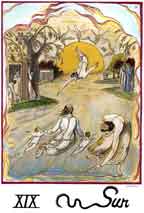 The
Sun card corresponds to the card of the same name in conventional Tarot. It
represents enlightenment, symbolized by the spiritual sun as the source of the
river of life. This scene exemplifies Blake's "fourfold vision," the
state of mystical ecstasy in which he sees the sun as "an innumerable company
of the heavenly host crying, 'Holy, Holy, Holy." This is the spiritual
Eden, a state of surpassing joy and beauty, arising from complete confidence
in one's direction. The central figure is Jesus, who glides upstream between
the banks of innocence (left) and experience (right), with the tree of life
growing on each side "and the leaves of the tree were for the healing of
nations." On the left shore, a woman picks the fruit of the tree and another
swaddles her child, while on the right shore two elders of wisdom stand with
a child of innocence. In the background, the two shores are spanned by the sun,
signifying that innocence and experience are joined at their source by imagination.
The
Sun card corresponds to the card of the same name in conventional Tarot. It
represents enlightenment, symbolized by the spiritual sun as the source of the
river of life. This scene exemplifies Blake's "fourfold vision," the
state of mystical ecstasy in which he sees the sun as "an innumerable company
of the heavenly host crying, 'Holy, Holy, Holy." This is the spiritual
Eden, a state of surpassing joy and beauty, arising from complete confidence
in one's direction. The central figure is Jesus, who glides upstream between
the banks of innocence (left) and experience (right), with the tree of life
growing on each side "and the leaves of the tree were for the healing of
nations." On the left shore, a woman picks the fruit of the tree and another
swaddles her child, while on the right shore two elders of wisdom stand with
a child of innocence. In the background, the two shores are spanned by the sun,
signifying that innocence and experience are joined at their source by imagination.
The children in the river represent the spirit and soul reborn as Adam and Eve, reminding us of Jesus's words, "unless you turn and become like children, you will never enter the kingdom of heaven." Jesus is not fully immersed in the river, as are the children, signifying his divine status. In the right forefront, a prominent woman with shears stoops to sever the thread of life and the cord of remembrance — the last attachments to old consciousness. She walks on the surface of the water, showing that she is not part of mortal life; she is Atropos, the Greek fate who cuts away the material flesh. To her, this is the 'river of forgetfulness', called Lethe. Soaring in front of the sun is St. John, an emblem of energy, coming to greet Jesus — a triple emphasis that "this world of imagination is the world of eternity." Note that St. John's right arm connects (the river and sun), while fate's left hand disconnects.
In the border, flames provide light from all directions, and their warmth symbolizes eternal love. In this card, humanity completes its development and reaches its perfection in the brotherhood of spiritual Eden.
KEYWORDS: ENLIGHTENMENT • DELIGHT • LIBERATION FROM OLD FORMS • RECOGNITION OF YOUR ACCOMPLISHMENTS • ENJOYMENT AND HAPPINESS IN LIFE • REALIZATION OF SPIRITUAL GOALS • FOURFOLD VISION, OR MYSTICAL SIGHT • RETURN TO THE SOURCE • IMAGINATION REALIZED •
The soul now puts aside its journey, having at last achieved the joy of enlightenment. The seeker now rests, basking in light. Yet, there can be more, for those who are accepted...
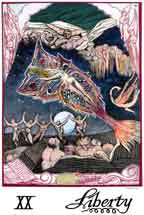 Liberty
corresponds to Judgement in conventional Tarot. In this collage of two images,
we meet Blake's character of Jerusalem, the Emanation of Albion. Named for the
holy city of peace, she represents mystic union with God, the divine vision
that is man's liberty. This card is God's command to wake from the "sleep
of Ulro," which is normal existence in the heavy world of matter, and liberate
oneself into the mystical view of life without end. A flaming angel at the right
blows its curved trumpet, which is the call to liberation and awakening: "A
mighty sound articulate — awake ye dead & come." Hearing the call,
the spirits of the dead in all their forms rise from the earth and issue from
beneath the mantle of existence in the sky; and some dance beneath the moon
in lunatic frenzy — including the leftmost one who looks over his shoulder
towards the waiting gallows.
Liberty
corresponds to Judgement in conventional Tarot. In this collage of two images,
we meet Blake's character of Jerusalem, the Emanation of Albion. Named for the
holy city of peace, she represents mystic union with God, the divine vision
that is man's liberty. This card is God's command to wake from the "sleep
of Ulro," which is normal existence in the heavy world of matter, and liberate
oneself into the mystical view of life without end. A flaming angel at the right
blows its curved trumpet, which is the call to liberation and awakening: "A
mighty sound articulate — awake ye dead & come." Hearing the call,
the spirits of the dead in all their forms rise from the earth and issue from
beneath the mantle of existence in the sky; and some dance beneath the moon
in lunatic frenzy — including the leftmost one who looks over his shoulder
towards the waiting gallows.
In the center, Blake's resplendent figure of Jerusalem, a metamorphic butterfly representing the spirit of human liberty, ascends upon a plume of flames. As the Emanation of Albion, Jerusalem too has been sleeping but now awakes. Her long hair streams forward, expressing her allure, and her arms are extended in loving acceptance of the entire universe before her. Embedded in her wings we see the sun, moon, and stars that represent the energies of the three previous cards, now combined in a single radiant symbol of the human capacity for spiritual transformation.
Although this card is sometimes associated with the concept of Last Judgment after physical death, its meaning for Blake is quite different. Judgment, or human liberation, occurs whenever error is eliminated, and this can happen at any time, individually or societally. For Blake, liberty must precede the ability to choose; with the ascension of Liberty, man is finally free to determine his own thoughts and actions.
In the upper border, angels with instruments amplify the call to awaken all souls. In the lower border, all the symbols relate to liberation: the living wheat of the spirit, the book of forgiveness that says, "love your enemies," and Blake's artistic tools — his palette, brushes, and graver, flanked by scrolls of inspiration.
KEYWORDS: A CALLING • AWAKENING TO FREEDOM • REBIRTH • METAMORPHOSIS • JUDGEMENT OF ONESELF AND OTHERS, AND BEING JUDGED • CHANGE OF STATE • RITE OF PASSAGE • DESIRE TO CREATIVELY MERGE WITH SOMEONE OR SOMETHING •
For those who have been called and are ready, Blake's message is: "awake thou sleeper...Albion awake. The trumpet of judgment hath twice sounded..."
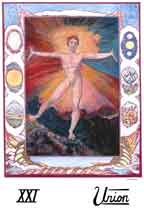 Union
corresponds to the World in conventional Tarot. This represents the ultimate
stage in the soul's journey, wherein all duality resolves into unity. The card
shows Albion standing on the same rock as in the Eternity and Innocence cards
— but now he is spiritually reassembled and his Humanity fully awakened.
At the end of Blake's prophetic epic poem entitled Jerusalem, Albion sacrifices
("annihilates") himself for Jesus, throwing himself into the "furnaces
of affliction," an act of love that inspires the Zoas to finally unite
and restore Albion to eternal
life.
Union
corresponds to the World in conventional Tarot. This represents the ultimate
stage in the soul's journey, wherein all duality resolves into unity. The card
shows Albion standing on the same rock as in the Eternity and Innocence cards
— but now he is spiritually reassembled and his Humanity fully awakened.
At the end of Blake's prophetic epic poem entitled Jerusalem, Albion sacrifices
("annihilates") himself for Jesus, throwing himself into the "furnaces
of affliction," an act of love that inspires the Zoas to finally unite
and restore Albion to eternal
life.
Albion is most of all a metaphor for a subjective state of mind, our own individual self-image. His spiritual regeneration shows our own possibilities for rebirth, for self-integrating into a new and sacred being. Although naked at the end just like at the start, the soul has undergone an inner evolution of consciousness, from descent and darkness to liberation and redemption. Although it appears the same, a revolution has occurred.
In the Tarot, this image portrays the joyful surrender with which the soul completes the journey. In the border, depictions of creation from Genesis flank Albion, the supreme creation. The upper left oval shows the creation of light on the first day; the middle oval shows the firmament dividing the waters on the second day; the lower left oval shows the gathering of waters to create dry land on the third day; then the upper right oval depicts the creation of the sun, moon, and stars as the lights of heaven on the fourth day; the middle oval shows the creatures of the sea and air being created on the fifth day; and the lower right oval shows the creatures of the land being created on the sixth day, along with man who is given dominion over all. Albion's pose expresses wonder and gratitude for these fruits of God's imagination.
This entire card is a fourfold vision of the world, with Humanity as the measure and master of all things. Below him in the border are symbols of the fate that Albion has transcended: Leviathan in the sea of time and space, and the worm of death coiled around a shrouded corpse. In the the border, two angels hold scrolls of inspiration. The left angel looks at the stars of Pleiades (the 'flock of doves' sacred to the goddess), symbolizing the feminine portion; and the right angel looks at the stars of Orion, symbolizing the masculine portion. These same stars are also in XVII—Stars, and so the hope expressed there during the Dark Night of the Soul now comes to fruition in the triumph of Union. The cloud joining the two angels is the unified spiritual body of man.
KEYWORDS: HUMANITY AWAKENED TO ITS DIVINITY • A NEW SPIRITUAL BEGINNING • INFINITE POTENTIAL • COMPLETION OF EFFORT • THE RAPTURE OF LIFE • SELF-ACTUALIZATION • UNIFICATION OF ALL THE ELEMENTS • ACCEPTING RESPONSIBILITY FOR YOURSELF AND YOUR CIRCUMSTANCES „ SELF-SACRIFICE FOR A HIGHER GOAL •
The story of the soul's journey — man's quest for wholeness — is now told; imagination makes all things possible.
We return to where we began. Eternity
in its aspect of infinity (![]() )
follows Union as the epilogue to the soul's journey, for eternity is the soul's
destination after its regeneration.
)
follows Union as the epilogue to the soul's journey, for eternity is the soul's
destination after its regeneration.
